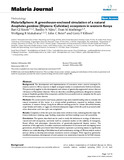MalariaSphere: A greenhouse-enclosed simulation of a natural Anopheles gambiae(Diptera: Culicidae) ecosystem in western Kenya

Date
2002-12-18Author
Knols, BGJ
Njiru, BN
Mathenge, EM
Mukabana, WR
Beier, JC
Killeen, GF
Type
Journal ArticleMetadata
Show full item recordAbstract
The development and implementation of innovative vector control strategies for malaria control in Africa requires in-depth ecological studies in contained semi-field environments. This particularly applies to the development and release of genetically-engineered vectors that are refractory to Plasmodium infection. Here we describe a modified greenhouse, designed to simulate a natural Anopheles gambiae Giles ecosystem, and the first successful trials to complete the life-cycle of this mosquito vector therein.
Methods
We constructed a local house, planted crops and created breeding sites to simulate the natural ecosystem of this vector in a screen-walled greenhouse, exposed to ambient climate conditions, in western Kenya. Using three different starting points for release (blood-fed females, virgin females and males, or eggs), we allowed subsequent stages of the life-cycle to proceed under close observation until one cycle was completed.
Results
Completion of the life-cycle was observed in all three trials, indicating that the major life-history behaviours (mating, sugar feeding, oviposition and host seeking) occurred successfully.
Conclusion
The system described can be used to study the behavioural ecology of laboratory-reared and wild mosquitoes, and lends itself to contained studies on the stability of transgenes, fitness effects and phenotypic characteristics of genetically-engineered disease vectors. The extension of this approach, to enable continuous maintenance of successive and overlapping insect generations, should be prioritised. Semi-field systems represent a promising means to significantly enhance our understanding of the behavioural and evolutionary ecology of African malaria vectors and our ability to develop and evaluate innovative control strategies. With regard to genetically-modified mosquitoes, development of such systems is an essential prerequisite to full field releases.
URI
http://dx.doi.org/10.1186/1475-2875-1-19http://erepository.uonbi.ac.ke:8080/xmlui/handle/123456789/14791
http://www.ncbi.nlm.nih.gov/pubmed/12537599
